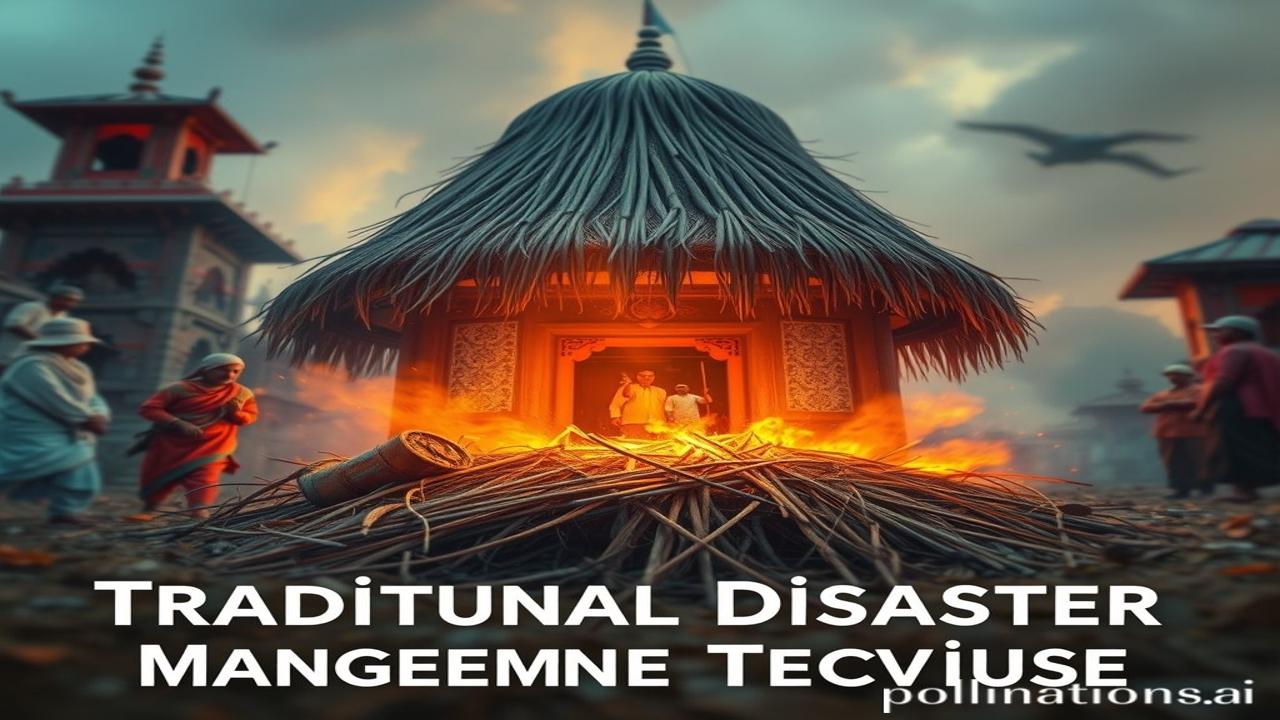Waqt Ki Nadi Mein Behti Parampara: Traditional Disaster Management Techniques
Kabhi socha hai, jab bijli kadakti thi aur badal garajte the, toh hamare purvaj kaise bachate the khudko? Koi modern tech toh tha nahi, phir bhi they survived… they thrived! Waqt ki dhool mein kuch aisi kahaniyan chhupi hain, jinhe aaj bhi yaad karna zaroori hai. These are the stories of resilience, innovation, and the deep understanding our ancestors had of nature’s fury. Let’s unearth the wisdom of traditional disaster management techniques.
Itihasik Prishthbhumi: Nature Se Samjhauta, Prakriti Se Samvad
Traditional disaster management techniques, yaani ki disaster se bachne ke purane tareeke, aren’t just about surviving; they’re about living in harmony with प्रकृति (Prakriti). This knowledge, passed down through generations, developed over centuries, maybe even millennia. Iska koi ek “date of origin” nahi hai. From the floodplains of the Indus Valley to the earthquake-prone regions of the Himalayas, different communities developed unique strategies to cope with calamities.
This is deeply intertwined with our culture because it’s about our relationship with the environment. It’s about understanding the rhythms of nature, respecting its power, and learning to anticipate its tantrums. It’s about building homes that can withstand earthquakes, storing food that can last through droughts, and creating social systems that support everyone in times of crisis. Imagine a world where every home was designed to be resilient, every village self-sufficient, and every individual knew how to respond to a natural disaster. That was the goal!
Zameeni Sach – Log Aur Jeevan: Kahaniyan Jo Zinda Hain
Think about the village elder, sitting under the banyan tree, predicting the onset of the monsoon based on the movement of ants and the behavior of birds. Or consider the communities in coastal areas who knew how to build homes on stilts to avoid floods, and could read the sea like a book, predicting tsunamis long before any modern warning system.
“Arre beta, aasman ka rang dekho, aaj toofan aayega,” Maaji told young Rohan, pointing to the swirling clouds. “Jaldi se ghar mein sab kuch surakshit kar do!” This knowledge wasn’t written in books; it was woven into the fabric of everyday life.
Imagine communities like the Bishnois of Rajasthan, who fiercely protect the environment, including trees and animals. Their sustainable practices, like water harvesting and efficient farming, acted as natural buffers against droughts and famines. This wasn’t just about survival; it was about Dharma – a moral obligation to protect and preserve nature.
Dharohar Aur Pehchan: Aaj Bhi Zinda, Kal Bhi Rahega
Do these traditional techniques have relevance today? Absolutely! While modern technology offers advanced warning systems and sophisticated disaster response strategies, the wisdom of our ancestors can still teach us valuable lessons. We see its presence in:
- Architecture: Traditional house designs adapted to local climates, like mud houses in arid regions or bamboo houses in flood-prone areas, are sustainable and resilient.
- Water Management: Ancient water harvesting systems like baolis (stepwells) and tanks are being revived to combat water scarcity.
- Community-based solutions: The emphasis on local knowledge and community participation, central to traditional disaster management, is now being integrated into modern disaster risk reduction strategies.
Yeh Bharatiyata (Indianness) ka hissa hai. It’s about recognizing that we are not separate from nature but an integral part of it. Our identity is deeply rooted in this understanding.
Mazedar Tathya Ya Bhram-Bhanjak: Myths & Realities
Log samajhte hain ki traditional techniques are outdated and irrelevant in the age of technology. Lekin asli sach yeh hai ki they are complementary. Technology can provide early warning, but traditional knowledge can help communities understand the risks and take appropriate action. For example, knowing which plants have medicinal properties for treating injuries after a disaster, or understanding traditional methods of water purification, can be life-saving.
Another misconception is that these techniques are only for rural areas. However, the principles of sustainable living, community resilience, and resource management are relevant to urban areas as well. Think about urban farming, rainwater harvesting in apartments, and building codes that incorporate traditional wisdom.
Drishya Aur Bhavnayen: Anubhav Ka Rang
Imagine the smell of earth after the first rain, the coolness of a mud house in the scorching summer, the rhythmic sound of a water wheel drawing water from a well. Feel the texture of hand-woven cloth made from locally grown fibers, hear the stories whispered around a crackling fire, see the light of a diya illuminating a community working together to rebuild after a flood. Yeh sab hamari dharohar hai, a sensory experience that connects us to our past and our future.
Antim Vichar Ya Uddharan: Aao, Samjhe Iski Shakti
Traditional disaster management techniques aren’t just about surviving disasters; they are about building resilient communities that are deeply connected to their environment. They represent a holistic approach that integrates ecological sustainability, social equity, and cultural preservation.
As the Sanskrit Shloka says:
“Sarve bhavantu sukhinah, sarve santu niramayah, sarve bhadrani pashyantu, maa kashchid dukha bhag bhavet”
(May all be happy, may all be free from illness, may all see what is auspicious, may no one suffer.)
This is the spirit of resilience, the essence of our tradition. Let’s rediscover and revitalize these ancient wisdoms, for a safer and more sustainable future.
